ISSN ONLINE(2278-8875) PRINT (2320-3765)
ISSN ONLINE(2278-8875) PRINT (2320-3765)
Priyanka Khatwani1, Archana Tiwari2
|
| Related article at Pubmed, Scholar Google |
Visit for more related articles at International Journal of Advanced Research in Electrical, Electronics and Instrumentation Engineering
EEG, or Electroencephalogram is a device used to analyse the activities of the brain when it is performing any task. EEG signal helps us to know about the brain functions and its activities and hence are helpful in the diagnosis of the neurobiological disorders in it.EEG signals have very low amplitude and are measured from peak to peak having normally vary from 0.5 to 100 μV in amplitude, which is about 100 times lower than ECG signals and so various types of noise can easily effect it. EEG signals play an important role in detecting brain related diseases so it is important to denoise these signals for correct analysis and diagnosis. Wavelet Transformsare helpful in denoising these signals and making them noise free. In this worka filter is used along with Wavelet Transform for Denoising the EEG signals. Performance analysis of these methods for noise removal is done by measuring parameters like MSE and PSNR.
Keywords |
| EEG, Wavelet Transform, MSE , PSNR. |
INTRODUCTION |
| The electroencephalogram (EEG) is the recordings of the electrical activity of the brain. It was recorded by Hans Berger for the first time in 1929[1]. The term EEG indicates that the brain activity emits the signal from head and can be drawn and recorded. Signals are produced by bombardment of neurons within the brain. It is measured by placing multiple electrodes over the scalp for 20 to 40 min. The researchers have found that these signals indicate the brain function and status of whole body. Therefore, EEG signal are helpful in providing valuable information about the brain functions and neurobiological disorders as it provides a visual display of the recorded waveform and allows computer aided signal processing techniques to identify them. This acts as a prime motivation to implement the advanced digital signal processing techniques for their analysis [2]. Real time automated EEG signal analysis in clinical settings is of great assistance to clinicians in detecting neurobiological diseases and prevention of the possibility of missing (or misreading) information. However, automated classification of EEG signals is a challenging problem as the morphological and temporal characteristics of EEG signals show significant variations for different patients and under different temporal and physical conditions. This ability motivates us to apply the advanced digital signal processing techniques on the EEG signals. The study of neuronal function and neurophysiological properties with EEG signals generation and their detection plays the vital role in detection, diagnosis of brain disorders and brain diseases. |
LITERATURE SURVEY |
| In the previous work in the field of denoising EEG signal various denoising methods like the ICA, PCA, Wavelet ICA, and Adaptive filtering methods were used for denoising purpose. The drawback in most of the approaches was the computational complexity. Also in methods like ICA, analysis of the signal was done in only time domain[2][6]. PCA was also used but in this method the accuracy achieved was less [4]. The ICA when combined with the wavelet method gave better results[8]. The adaptive filtering methods gave the worst results when used for denoising. All the simulation work is done in MATLAB. From the literature survey it can be concluded that the wavelet method proves to give better results for the denoising as it supports multi resolutional properties. In this paper a conventional filter is implemented before implementing wavelet transform. |
EEG SIGNAL GENERATION |
| HumansâÃâ¬ÃŸ Central Nervous System (CNS) consists of two cells and they are Nerve cells and Glia cells. The nerve cell contains axons, dendrites and cell bodies. The proteins developed in the cell body are transmitting information to other parts of the body. The long cylindrical shaped axon transmits the impulse which is electrical in nature. Dendrites are connected either to the axons or dendrites of other inside cells and receive the electrical impulse from other nerves cells. The study of brain found that each nerve of human is approximately connected to 10000 other nerves. The electrical activity is mainly due the current flow between the tip of dendrites and axons, or between dendrites to dendrites of cells. The voltage level of these signals is in mV range and its frequency is less than 100Hz [3]. |
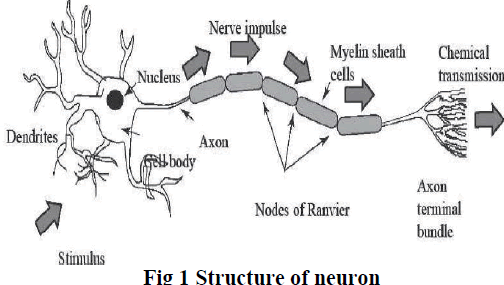 |
FREQUENCY BANDS OF EEG SIGNALS |
| Most of EEG waves range from 0.5-500 Hz, however following five frequency bands are clinically relevant: (i) delta, (ii) theta, (iii) alpha, (iv) beta and (v) gamma.[5] |
| Delta waves: Delta waves frequency is up to 3 Hz. It is slowest wave having highest amplitude. It is dominant rhythm in infants up to one year and adults in deep sleep. |
| Theta waves: It is a slow wave having frequency range from 4 HZ to 7 Hz. It emerges with closing of the eyes and with relaxation. It is normally seen in young children or arousal in older children and adults. |
| Alpha waves: Alpha activity has frequency range from 7 HZ to 12 Hz. it most commonly seen in adults. Alpha activity occurs rhythmically on both sides of the head but are often slightly higher in amplitude on the non-dominant side, especially in right-handed individuals. Alpha wave appears with closing eyes (relaxation state) and disappears normally with opening eyes/stress. It is regarded as a normal waveform. |
| Beta waves: Beta activity is fast having small amplitude. It has frequency range from 14 HZ to 30 Hz. It is the dominant rhythm in patients who are alert or anxious or who have their eyes open. Beta waves usually seen on both sides in symmetrical distribution and is most evident frontally. It may be absent or reduced in areas of cortical damage. It is generally regarded as a normal rhythm and observed in all age groups. These are mostly appeared in frontal and central portion of the brain. The amplitude of beta wave is less than 30 μ V. |
PROBLEM IDENTIFICATION |
| Electroencephalography (EEG) signals provide valuable information about the brain and neurobiological problems. ButEEG recordings are associated by various types of noises which is a problem in the proper analysis of the brain signals. As the EEG recordings of patients are very important for analysing the diseases related to brain so it is necessary to remove these noises from the signals and various approaches for removal or suppression of the noise will be help full in analysing the signals in a proper manner. The EEG recordings contain that data in which it becomes difficult to find out the noisy signals as the voltage level is considered while checking the waveforms and to detect any disease in the patientâÃâ¬ÃŸs .EEG signals contains spikes which acts as noise and they have very small amplitudes which are difficult to examine because of this it becomes necessary to remove noise from the EEG signals. The problem also comes in the data base collection of the various patients. Various artifacts such as the eyesblinking, ocular artifacts, and movement of eyeballs extra create noise and to detect such noise is difficult [10]. All these problems arise during EEG recordings of patients and for proper diagnosis it is very important to make the signals noise free. |
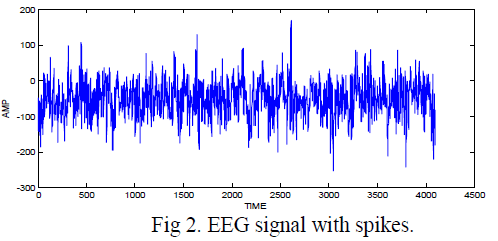 |
| The above figure shows the EEG signal with spikes which is plotted in Fig 2. |
WAVELET TRANSFORM |
| The term „waveletâÃâ¬ÃŸ refers to an oscillatory vanishing wave with time-limited extend, it has the ability to describe the time-frequency plane, with atoms of different time supports Generally, wavelets are crafted to have specific properties which makes them useful for signal analysis. They represent a suitable tool for the analysis of non-stationary or transient phenomena [9][10]. Wavelet is a mathematical tool that can be used to extract information from many kinds of data, including audio signals and images. Mathematically, the wavelet, is a function of zero average, having the energy concentrated in time [11][12].The equation is given below: |
| In order to be more flexible in extracting time and frequency informationâÃâ¬ÃŸs, a family of wavelets can be constructed from a function (t), also known as the „Mother WaveletâÃâ¬ÃŸ, which is confined in a finite interval. „Daughter WaveletsâÃâ¬ÃŸ, are then formed by translation with a factor u and dilation with a scale parameter s: |
| In wavelet denoising we decompose the signals in to high frequency components and low frequency components using the threshholding method. The two threshholding methods available are hard thresholding and soft threshholding. And then we select the best wavelet from the wavelet families which can best decompose the noisy signal and again we reconstruct the signals. The methodology of wavelet transform method is shown in below fig 3[5]. |
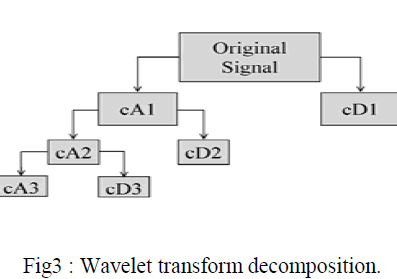 |
| In the above figure the decomposition of the signal is shown. The original signal is decomposed in to approximation and detail components. The low frequency components are again further decomposed denoted as CA 2 and CD2 and so in in the figure. |
WAVELET FAMILY |
| In wavelet transform basis function can be produced through translation and scaling the mother wavelet. As the mother wavelet produces all the basis functions which determine the characteristics of resultant wavelet transform, the selection of appropriate mother wavelet is necessary for finding of the wavelet transform effectively. Some of the wavelet families are discussed below. |
Haar wavelet |
| Any discussion of wavelets begins with Haar wavelet, the first and simplest. Haar wavelet is discontinuous, and resembles a step function. In mathematics, the Haar wavelet is a sequence of rescaled "square-shaped" functions which together form a wavelet family or basis. The Haar sequence is now recognised as the first known wavelet basis and extensively used as a teaching example. The Haar sequence was invented by Alfréd Haar. . The study of wavelets, and even the term "wavelet", did not come until much later. The Haar wavelet is also the simplest possible wavelet. The technical disadvantage of the Haar wavelet is that it is not continuous, and therefore not differentiable. |
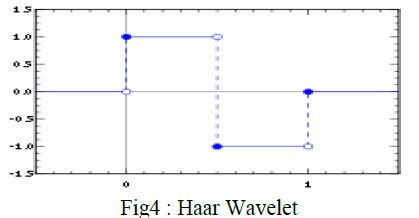 |
Symlet wavelet |
| Symlet wavelet is the advancement of Daubechies wavelet. The symlets are more symmetric than the extremal phase wavelets. In symN, N is the number of vanishing moments. Symlet can be orthogonal, Biorthogonal or symmetrical. |
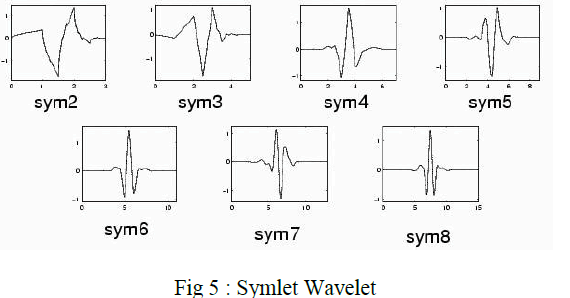 |
PROPOSED METHODOLOGY |
Cascaded filter - Wavelet Transforms: |
| First of all the signal is loaded in Matlab .In this method conventional filtering is applied to the EEG signals and then a wavelet filter is applied to the signal obtained after filtering. The conventional filter which is being used here is a Butterworth filter. The sampling frequency and the high pass and low pass frequency for filtering is set. Butterworth filter is used for filtering EEG data, as it has monotonic and maximum possible flat frequency response in the pass band. Also transition bandwidth of the Butterworth filter reduces with the increase in filter order. After passing the Signal though the filter wavelet transform is applied. The wavelets used are Symlet and Haar and their performance is evaluated by measuring MSE and PSNR. |
| The Evaluation Parameters used are the SNR and the MSE. The more the SNR and less the MSE value of the signal the signal is considered as noise free. The formula used for the PSNR and MSE calculation is given below [14]. |
 |
| Where x(n) is original signal and xâÃâ¬ÃŸ(n) is denoised signal. |
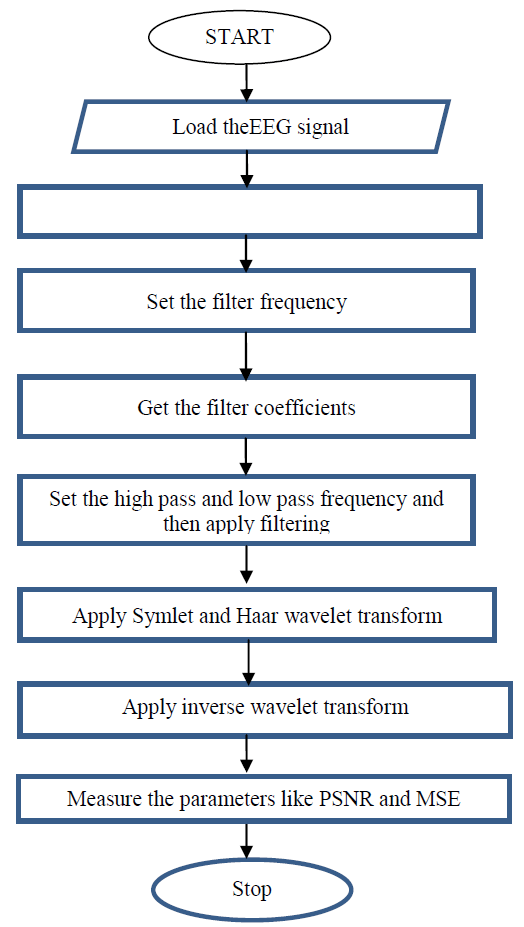 |
| Fig6 Flow chart of Methodology for Cascaded filter-Wavelet Transform. |
RESULTS |
| The EEG data base is plotted in Matlab for analysis. A fix value of SNR is provided and then the signal is denoised by using Symlet and Haar wavelets .The decomposition level used is 2, 3 and 4. For performance of different wavelets parameters like MSE and PSNR is calculated. Now results are also obtained for cascaded wavelet transform method. It can be seen from Table 2 that the Sym4 in combination with the filter is giving very low values of MSE and high PSNR value which is desirable so it can be used for denoising. In reference to the paper cited in references a different method is implemented and PSNR value is increased also extra parameter MSE is calculated and its value is reduced by implementing cascaded filter- wavelet transform as compared to simple wavelet transform. |
| For decomposition Level 2 and SNR 20db following results are obtained for cascaded filter- wavelet transform. |
 |
| Table no 1 shows the results for the decomposition level 2 for different wavelet . |
| For decomposition Level 3 and SNR 20db following results are obtained for cascaded filter- wavelet transform. |
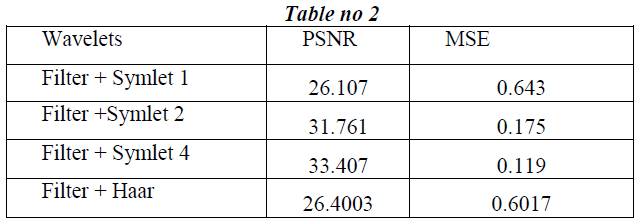 |
| Table no 2 shows the results for the decomposition level 3for different wavelet. |
| For decomposition Level 4 and SNR 20db following results are obtained for cascaded filter- wavelet transform. |
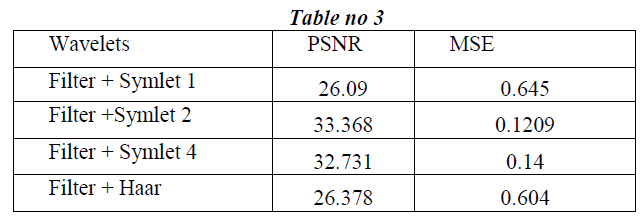 |
| Table no 3 shows the results for the decomposition level 4 for different wavelets. |
CONCLUSION |
| In this paper Symlet and Haar wavelet were applied for denoising and level of decomposition was 2, 3 and 4 the wavelets were used after the filters this method is Cascaded filter wavelet transform. From the present paper it is being concluded that Symlet 4 wavelet for decomposition level 3 is giving the Maximum value of PSNR and low value of MSE when it is combined with filter. Hence it is the best suited for the denoising purpose. |
References |
|